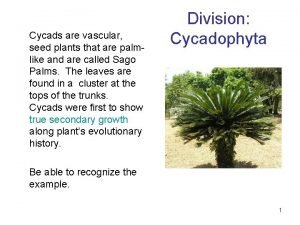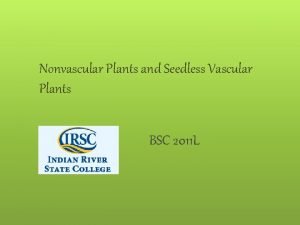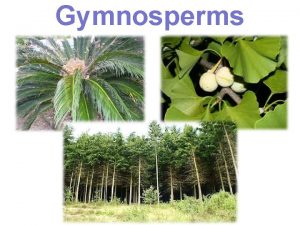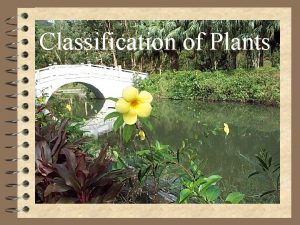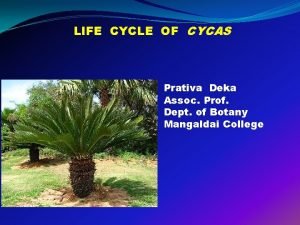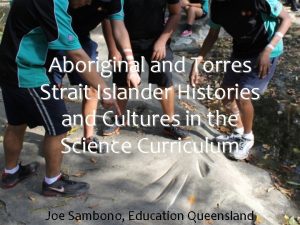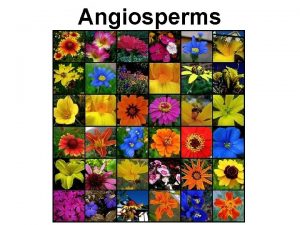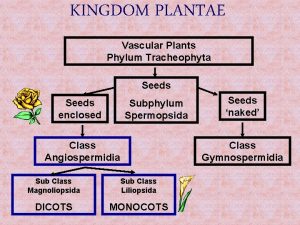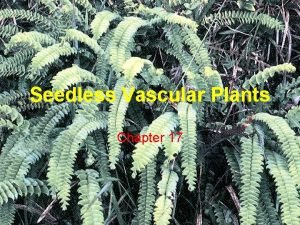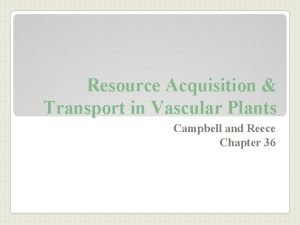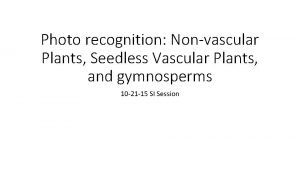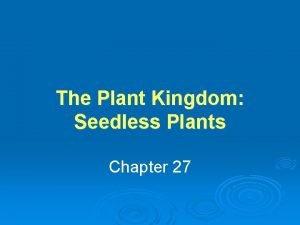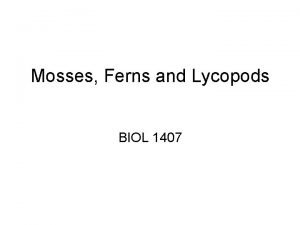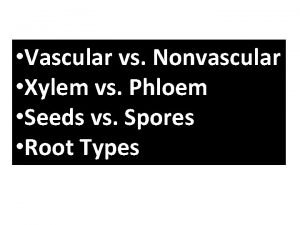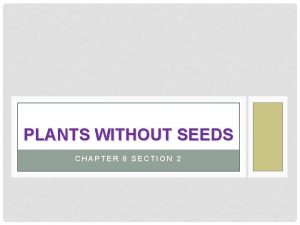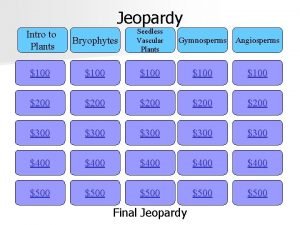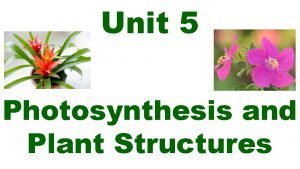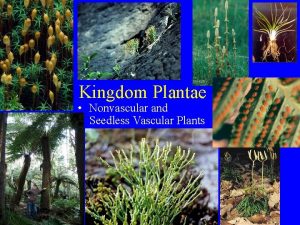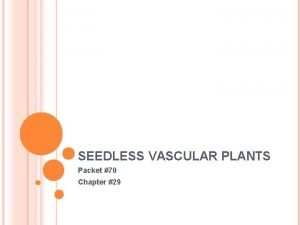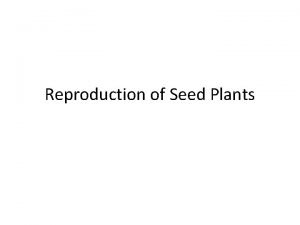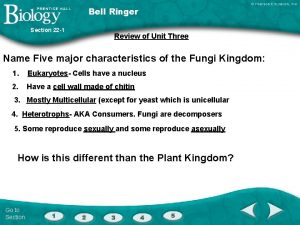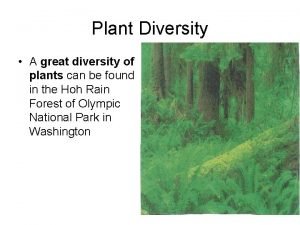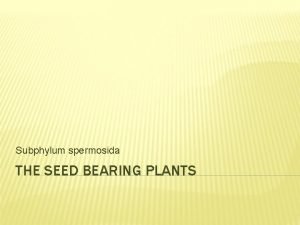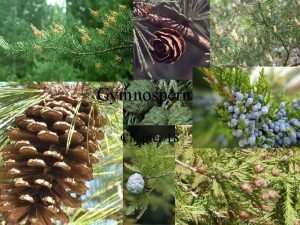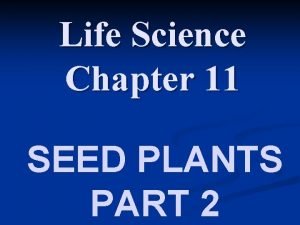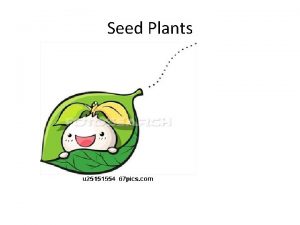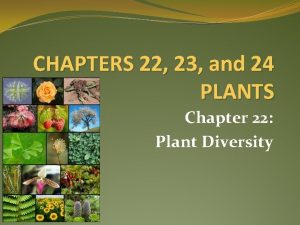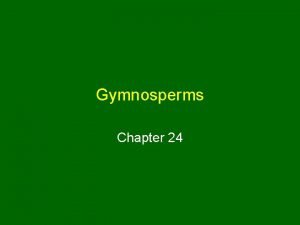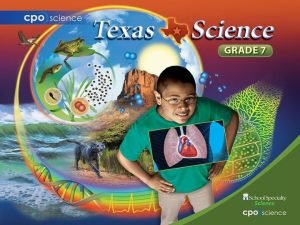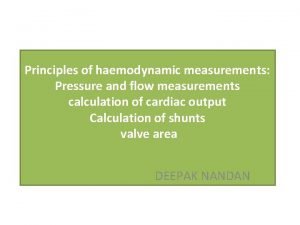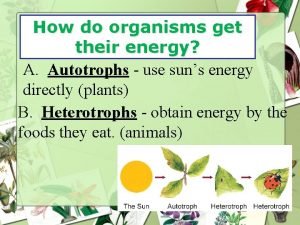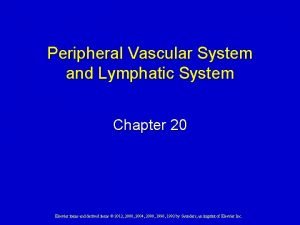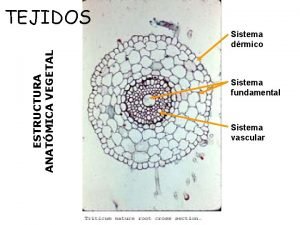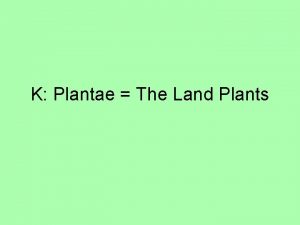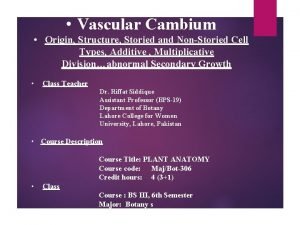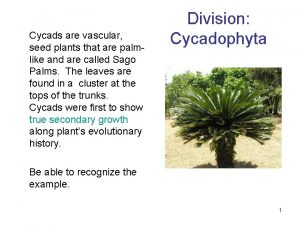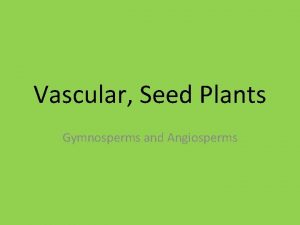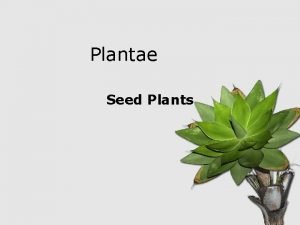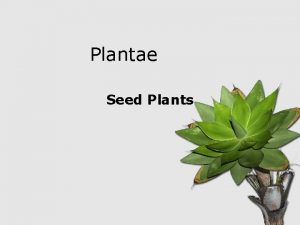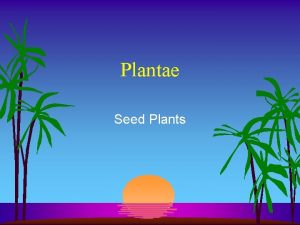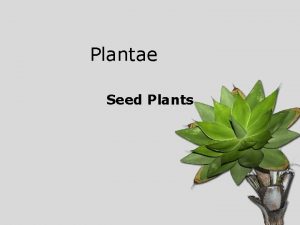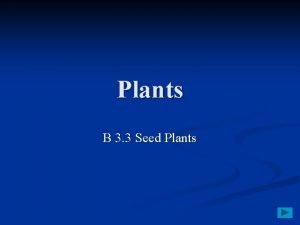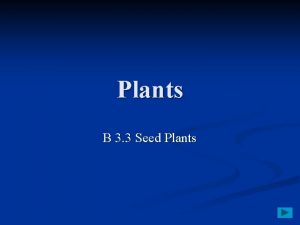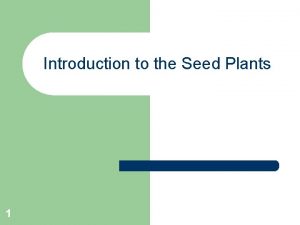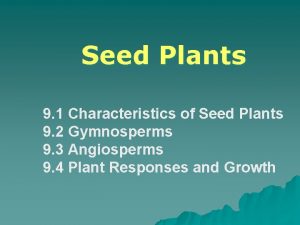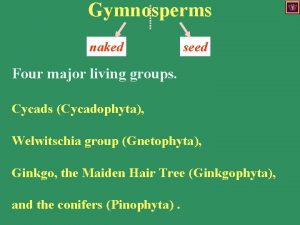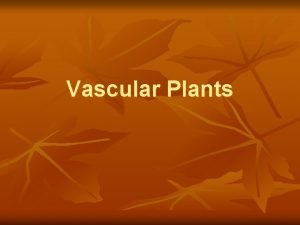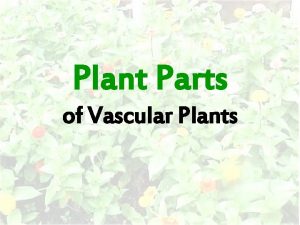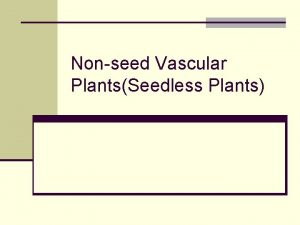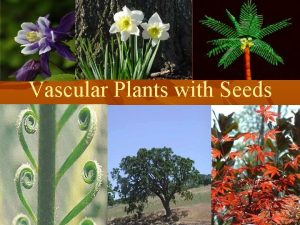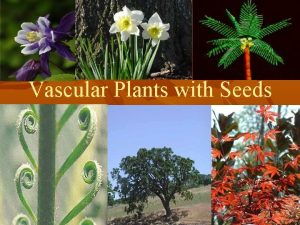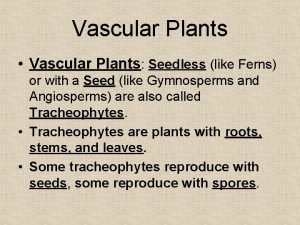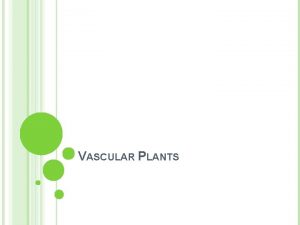Cycads are vascular seed plants that are palmlike






















































- Slides: 54

Cycads are vascular, seed plants that are palmlike and are called Sago Palms. The leaves are found in a cluster at the tops of the trunks. Cycads were first to show true secondary growth along plant’s evolutionary history. Division: Cycadophyta Be able to recognize the example. 1

The Ginkgo or Maidenhair Tree have characteristic fan-like leaves. There is only one species (from China) that has survived. Only males are usually planted in yards because the female plants have messy and foul smelling fruit. Be able to recognize the example in the jar. Division: Ginkgophyta 2

The Gnetophytes are unique gymnosperms because they have vessel elements. Our example is Ephedra or Mormon Tea. It produces a drug called ephedrine which raises the heart rate and raises blood pressure. Be able to recognize the example. Division: Gnetophyta 3

The Conifers, which include pines, spruces, hemlocks, and firs, are woody trees or shrubs. Most conifers have leaves (megaphylls) that are modified into needles or scales. Division: Coniferophyta Be able to recognize the example. 4

The Pine Tree contains both male and female cones. The pollen (staminate) cones are found low in the tree and produce pollen. The ovulate cones are high in the tree and produce seeds. Division: Coniferophyta 5

The male (staminate) cone consists of protective scales called (microsporophylls) that contain microsporangia which go through meiosis to produce four haploid microspores. These microspores will develop into pollen. Male Cones 6

Pollen Grains The microspores develop into pollen grains. Each pollen grain consists of four cells and a pair of wings which are used for dispersal. 7

Pollen Grains with Pollen Tube Microsporangia produce pollen grains with 4 cells: 2 prothallial cells, 1 generative cell (which becomes a sterile cell and a spermatogenous cell) and one tube cell. The spermatogenous cell produces 2 sperm. Be able to recognize the pollen grain, wings, pollen tube, and sperm. 8

The female (ovulate) cone consists of protective scales called (megasporophylls) that contain megasporangia (ovules). The megaspore mother cells produce 4 megaspores through the process of meiosis. The megaspores are surrounded by a nutritional nucellus and a protective seed coat called an integument. The megaspores develop into a female gametophyte. Female Cones 9

At the end of the female gametophyte (n), an archegonium (n) which contains two eggs (n) that develop. They are surrounded by two layers of tissue, the nucellus (2 n) and the integument (2 n). The integument has a channel that allow sperm in (a micropyle) and the two layers are separted by a pollen chamber. Female Gametophyte 10

The pine embryo consist of an integument, an endosperm (food source), cotyledons (food source), the hypocotyl (that develops into the shoot system), and the radicle (which develops into the root system). While developing, one of the layers of the integument will become a seed coat for the seed. Female Cone with Mature Embryo 11

Angiosperm Be able to recognize the parts of a flower and know their functions 12

Ovary Position When the ovary is embedded below the calyx and corolla, it is called epigynous. When the ovary is produced on top of they parts, it is called hypogynous. When the ovary is centrally positioned it is called perigynous. Be able to recognize these positions on the drawing. 13

Placentation The position of the ovary where the ovules (seeds) attach is called placentation. There are three types of arrangements: parietal (top), axial (middle), and free central (bottom). pigynous. Be able to recognize these positions on the drawing. 14

Male Gametophyte The male gametophyte in flowering plants is a pollen grain. They are produced in anthers. The anthers have fours chambers that produce quartets of pollen. The quartets break into individual pollen grains. 15

Fertilization The majority of plants do not self-fertilize themselves. They depend on cross fertilization: the transfer of pollen from one individual plant to another. The most common mechanism to keep plants from fertilizing themselves is called are produced in self-incompatibility. This works similar to an animal’s immune system where a biochemical block prevents the pollen from completing its development. 16

Germinating Pollen Under suitable conditions, the tube cell grows into a pollen tube (with a tube nucleus) inside the style of another flower. As the tube grows, the generative nucleus lags behind and eventually produces two sperm. 17

Female Gametophyte In the female gametophyte, the ovule (surrounded by the ovary wall) develops an embryo sac which goes through the process of meiosis to create a megaspore. The megaspore than goes through mitosis twice to produce the four-nucleate stage. 18

Female Gametophyte The 8 -nucleate stage ovary. The emryo is located within the embryo sac which contains 3 antipodals (which disappear after fertilization), 2 polar nuclei (which join with a sperm that produces the endosperm (3 n), 2 synergids (which disappear), and an egg (which is fertilized). Because a sperm joins an egg and another fuses with the polar nuceli in flowering plants, it is called double fertilization. 19

Seeds Be able to recognize the parts labeled in the diagram to the right. 20

Fruit and Seed Dispersal by Wind: Many fruits have a wing to allow for dispersal and may be carried up to six miles away. Fruits that are too large may even be rolled along the ground due to the wind. Seeds themselves may be winged or small enough to be moved by a slight breeze. 21

Fruit and Seed Dispersal by Animal: Birds, mammals and ants all act as dispersal agents. These seed or fruits can be carried and dropped, collected and stored, eaten and passed through a digestive tract, or stuck in a mammals’s fur or a bird’s feather’s. Humans are the most efficient transporters of fruits and 22 seeds.

Fruit Wall The fruit wall is a mature ovary. The skin forms the exocarp while the inner boundary around the seed(s) forms the endocarp. The are between these two areas is called the mesocarp. The three regions collectively are called the pericarp. In dry fruits, the pericarp is often very thin. 23

Roots are used to anchor the plant in the soil, to absorb minerals and water, conduct minerals and water and store food. 24

Root Tip Regions Function Root Cap Protect the apical meristem Perception of Gravity Cell Division Production of new cells Pushes meristem and root cap through ground Development of protoderm, procambium, ground tissue Apical Meristem Elongation Maturation 25

Monocot Root Tissue Origin Function Epidermis Protoderm Produce root hairs, protection, absorption Stele Procambium Xylem: water movement Phloem: food movement Pericycle: lateral roots Cortex Ground Meristem Cortex: storage Endodermis: regulation of movement Passage Cells: lateral movement of water 26

Monocot Root The three primary meristems give rise to the three primary tissues of roots. (protoderm, procambium, and the ground meristem). You will be beld responsible for the following tissues: Epidermis, Stele, Xylem, Phloem, Pericycle, Cortex, Endodermis, and Passage Cells. You also need to know their functions. 27

Dicot Root A dicot root differs from a monocot root because it usually lacks a pith. The three primary meristems give rise to the three primary tissues of roots. (protoderm, procambium, and the ground meristem). You will be beld responsible for the following tissues: Epidermis, Stele, Xylem, Phloem, Pericycle, Cortex, Endodermis, and Passage Cells. You also need to know their functions. 28

Dicot Root Tissue Origin Function Epidermis Protoderm Produce root hairs, protection, absorption Stele Procambium Xylem: water movement Phloem: food movement Pericycle: lateral roots Cortex Ground Meristem Cortex: storage Endodermis: regulation of movement Passage Cells: lateral movement of water 29

Carrot A carrot is a modified taproot. Look at a longitudinal and cross section of a carrot (Daucus) root and be able to identigy the following structures: Cortex, stele, pericycle and lateral roots. The cortex and stele are separated by a white line called pericycle. Small white lines can be seen going from the pericycle to the outside. These are the lateral roots. 30

As the root of a young seedling grows, it penetrates the soil. Epidermal cells produce root They absorb water and dissolved minerals from the soil. The small size and larger number of hairs enormously increase the absorptive surface of the root and bring it in contact with a large volume of soil. For optimum growth, the soil should be loosely packed in order to allow for gas exchange. Observe the living radish seedlings (Rhaphanus) under a dissecting scope. The white strings along the roots are the root hairs. Root Hairs 31

Vascular tissue running the length of a stem composed of primary tissue is called a vascular bundle. Vascular bundles are made up of xylem (usually seen in red) which face the pith and phloem (usually seen in green) which faces the cortex. Be able to recognize the difference between the two tissues. Vascular Bundles 32

In stems of herbaceous plants, there is usually only primary tissue. Identify the following structures: vascular bundles, pith, epidermis, fibers, phloem, and xylem. Notice that the vascular tissue is found in vascular bundles arranged in a ring. usually seen in red) Inside the ring is a collection of ground tissue called the pith. The fibers stain red and they are found on the outer tips of the vascular bundles. The fibers add support. Herbaceous Dicot Stem (Ranunculus) 33

The tissue arrangement in monocot stems differ from that of dicots. The vascular bundles are scattered and not found in any set pattern. The xylem is usually found toward the center of the stem and the phloem is usually facing outward within a vascular bundle. Look at the prepared slide of a scross section (CS) of the herbaceous monocot Zea (corn). The monocot stem does not have a true pith. Herbaceous Monocot Stem 34

Woody Dicot Stem Most vascular plants undergo secondary growth, which increases girth (width). Two lateral meristems are responsible for secondary growth: the vascular cambium which produces xylem and pholem: and the cork cambium which produces a tough covering called bark. Secondary growth occurs in all gymnosperms and most dicot species of angiosperms but is rare in monocots. We will observe prepared slides of the tree basswood (Tilia) to demonstrate the different tissues moving from the inside to the outside of the stem. 35

Woody Dicot Stem 36

Woody Dicot Stem Tissue Function Pith Storage Primary Xylem Moves water and minerals upward Secondary Xylem Moves water and minerals upward Vascular Cambium Produces secondary growth Secondary Phloem Moves nutrients around the plant Primary Phloem Moves nutrients around the plant 37

Woody Dicot Stem (Continued) Tissue Function Cortex Storage Phelloderm Made of parenchyma cells Unknown function Produces phelloderm and cork cells Physical barrier for protection Cork Cambium Cork Cells 38

Age of a Woody Dicot The age of a dicot can be determined by counting the number of rings. The rings are made up of dead cells called xylem. The type of year (rainfall amounts) can be determined by the width of the ring. 39

Tissues of a Tree Trunk By examining a cross section of a mature tree, many important regions can be seen by the unaided eye. Sapwood and heartwood are made up of secondary xylem. Sapwood is younger and function for water movement. Heartwood is older, darker wood that no longer functions for water movement and is used for support. 40

Spiral Xylem Vessels Conifers have xylem that consist primarily of tracheids; no fibers or vessel elements. The wood tends to be soft and is often called soft woods. The woods of woody dicots possess vessels elements and tend to be hard and are called hard woods. Xylem vessels in woody dicots are spiral in shape. These special cells are used for carrying water and minerals upward in the stem. Be able to recognize a spiral xylem vessel from the melon 41 plant Cucurbita.

42

The Leaf Leaves are the photosynthetic organs of the plant. Leaves act as solar panels that capture sunlight and convert solar energy into chemical energy in the form of sugars using carbons dioxide and water. The structure of a leaf can actually be divided into three major regions: the epidermis, the mesophyll, and the veins (vascular bundles). Observe the cross section (CS) of a leaf. You will be held responsible for the following regions, structures and functions. 43

The Leaf Region Structure Function Epidermis Cuticle Prevents water loss Epidermal Cells Guard Cells and Stomates Pallisade Layer Spongy Layer Protective layer Mesophyll Veins Vascular Bundles Gas Exchange Photosynthesis and gas exchange Transport 44

The Lower Epidermis Look at the prepared slide of the lower epidermis (Sedum – CS) Be able to recognize the following structures: Guard cells, stomates, lower epidermal cells. The epidermal cells will look like puzzle pieces. The guard cells are regulated by turgor pressure. When they are full, the stomates are open. When they are empty, the stomates are closed. 45

Pine Needles Pine trees have adaptations for living in arid conditions. In arid regions, one of the largest problems faced by plants is water loss through the stomates. Pine needles have their stomates recessed (sunken) within the surface of the leaf. Observe a cross section (CS) of a pine needle and be able tecognize the following structures: guard cells and stomata. 46

Minerals and Plant Nutrition Plants need certain nutrients to do well. Know the following symptoms and their causes. Chlorosis – lack of N or K Deep Green or Purple Pigmentation – lack of P or N Stunted Growth – lack of P or N Necrosis – Lack of K 47

Pitcher Plants Pitcher plants are found in damp, boggy soils in northeast Florida, which are deficient in nitrates and phosphates. They capture their prey by having their funnel shaped leaves covered with nectar glands and down curved teeth. Once the insect lands, they move down to a slick area with no foothold. The insect falls into the fluid at the bottom where it is absorbed. 48

Venus Flytraps are found in damp, boggy soils in the Carolinas, which are deficient in nitrate. They capture their prey by using their modified leaves that contain two lobes. Each lobe has an outer area that contains teeth. Each lobe has trigger hairs that signal the leaves to close on their prey (flies or larger insects – smaller insects can escape). 49

Sundews are found in acid, boggy soils, along roadside ditches, which are deficient in nitrates. They capture their prey by having modified leaves that contain stalked glands or tentacles which contain highly viscid mucus. They catch only small or very weak prey. Flies and ants can escape. 50

Gibberellins Gibberellic Acid effects germination. Observe the seeds that were treated with the hormone and compare them to the control seeds. Gibberellic acids promote seed germination and plants treated with it will grow quicker. This hormone could be used to speed up growth in agricultural plants. 51

Gibberellins Gibberellic Acid effects growth rate. Observe the plants that were treated with the hormone and compare them to the control plants. Gibberellic acids promote stem elongation and plants treated with it will grow longer. This hormone is used to produce flower shoots but can cause problems if the stems grow too quickly. 52

Some researchers believe it is the tip of the plant. Observe the plant that was placed next to a light. Auxin is the hormone that is thought to be responsible for the plant bending toward the light. It is the stem that is actually “bending”. The plant actually doesn’t bend. The cells away from the light are affected more by auxin and elongate faster which “bends” the plant toward the light. Phototropism 53

Shoots display a negative gravitropism. Observe the plant that was placed on its side. Plants may tell up from down by the settling of Statoliths (plastids with heavy starch grains). Auxin is the hormone that is though to be responsible for the plant “bending” upward. The stem actually doesn’t bend. The cells on the bottom of the plant are more affected than the upper cells and elongate faster which “bends” the plant upward. Gravitropism 54
 Archegonium
Archegonium Non vascular plant reproduction
Non vascular plant reproduction Non vascular vs vascular plants
Non vascular vs vascular plants Seedless vascular plants gymnosperms
Seedless vascular plants gymnosperms Nonvascular plants definition
Nonvascular plants definition Mikael ferm
Mikael ferm Vascular and non vascular difference
Vascular and non vascular difference Life cycle of cycas
Life cycle of cycas Aboriginal detoxification of cycads chemistry
Aboriginal detoxification of cycads chemistry Corraloid
Corraloid Vascular seed
Vascular seed Enclosed seeds
Enclosed seeds Vascular
Vascular Resource acquisition and transport in vascular plants
Resource acquisition and transport in vascular plants Gymnosperm phylum
Gymnosperm phylum Microphylls
Microphylls Is a fern sporophyte or gametophyte
Is a fern sporophyte or gametophyte Which seedless plants have been used to treat burns?
Which seedless plants have been used to treat burns? Vascular vs nonvascular plants
Vascular vs nonvascular plants Chapter 8
Chapter 8 Angiosperms _____.
Angiosperms _____. Nodes and internodes
Nodes and internodes Phylum and species
Phylum and species Phyla of seedless vascular plants
Phyla of seedless vascular plants Why are nonvascular seedless plants only a few cells thick
Why are nonvascular seedless plants only a few cells thick Gây tê cơ vuông thắt lưng
Gây tê cơ vuông thắt lưng Tìm vết của mặt phẳng
Tìm vết của mặt phẳng Thơ thất ngôn tứ tuyệt đường luật
Thơ thất ngôn tứ tuyệt đường luật Sau thất bại ở hồ điển triệt
Sau thất bại ở hồ điển triệt Con hãy đưa tay khi thấy người vấp ngã
Con hãy đưa tay khi thấy người vấp ngã Thơ thất ngôn tứ tuyệt đường luật
Thơ thất ngôn tứ tuyệt đường luật Ngoại tâm thu thất chùm đôi
Ngoại tâm thu thất chùm đôi Walmart thất bại ở nhật
Walmart thất bại ở nhật Tôn thất thuyết là ai
Tôn thất thuyết là ai Block xoang nhĩ
Block xoang nhĩ Parts of seeds and their functions
Parts of seeds and their functions Seed plants reproduction
Seed plants reproduction Section 22-4 seed plants answer key
Section 22-4 seed plants answer key Cooksonia
Cooksonia Sepal function
Sepal function Ginkophyta
Ginkophyta Lesson 11: seed plants
Lesson 11: seed plants Seed plants are divided into two groups called
Seed plants are divided into two groups called Section 22-4 seed plants
Section 22-4 seed plants Ecological importance of gymnosperms
Ecological importance of gymnosperms Lesson 11 seed plants
Lesson 11 seed plants Genesis all seed bearing plants
Genesis all seed bearing plants Non flowering plants classification
Non flowering plants classification Photosynthesis equation
Photosynthesis equation How to calculate systemic vascular resistance
How to calculate systemic vascular resistance A multicellular autotrophic organism with vascular tissue
A multicellular autotrophic organism with vascular tissue Peripheral vascular system
Peripheral vascular system Clerenquima
Clerenquima Seedless vascular plant
Seedless vascular plant Endothelial permeability
Endothelial permeability
